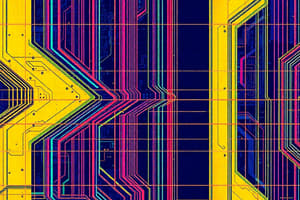Podcast
Questions and Answers
______ uses a minimum of two disks with a maximum of 32 disks: Figure 10: ______ This is known as a stripe set, as the data is written across Disks 1-3 in 64 KB stripes. Should one disk fail, then all of the data will be lost, so ______ does not provide fault tolerance or redundancy. The benefit of ______ is its faster read access, so it may be used for the proxy server's cache. RAID 1: RAID 1 is two disks, known as a mirror set
______ uses a minimum of two disks with a maximum of 32 disks: Figure 10: ______ This is known as a stripe set, as the data is written across Disks 1-3 in 64 KB stripes. Should one disk fail, then all of the data will be lost, so ______ does not provide fault tolerance or redundancy. The benefit of ______ is its faster read access, so it may be used for the proxy server's cache. RAID 1: RAID 1 is two disks, known as a mirror set
RAID 0
______ is two disks, known as a mirror set: |||||||||||||||||||| Figure 11: ______ Technet24 |||||||||||||||||||| |||
______ is two disks, known as a mirror set: |||||||||||||||||||| Figure 11: ______ Technet24 |||||||||||||||||||| |||
RAID 1
There is a need for the disk setup on servers to provide ______; this is where if one disk fails, the data is still available. We have already looked at failover clustering in Chapter 5, Understanding Network Components, where two servers share a quorum disk— the single point of failure in that scenario would be the shared disk. We are going to look at different Redundant Array of Independent Disks (RAID) levels and their characteristics
There is a need for the disk setup on servers to provide ______; this is where if one disk fails, the data is still available. We have already looked at failover clustering in Chapter 5, Understanding Network Components, where two servers share a quorum disk— the single point of failure in that scenario would be the shared disk. We are going to look at different Redundant Array of Independent Disks (RAID) levels and their characteristics
redundancy
______ does not provide fault tolerance or redundancy. The benefit of ______ is its faster read access, so it may be used for the proxy server's cache
______ does not provide fault tolerance or redundancy. The benefit of ______ is its faster read access, so it may be used for the proxy server's cache
______ uses a minimum of two disks with a maximum of 32 disks: Figure 10: ______ This is known as a stripe set, as the data is written across Disks 1-3 in 64 KB stripes
______ uses a minimum of two disks with a maximum of 32 disks: Figure 10: ______ This is known as a stripe set, as the data is written across Disks 1-3 in 64 KB stripes
What is the purpose of setting up a disk in servers with redundancy?
What is the purpose of setting up a disk in servers with redundancy?
How many disks are required for RAID 0 and what is its characteristic?
How many disks are required for RAID 0 and what is its characteristic?
What is the characteristic of RAID 0 in terms of fault tolerance and data loss?
What is the characteristic of RAID 0 in terms of fault tolerance and data loss?
What is the setup and characteristic of RAID 1?
What is the setup and characteristic of RAID 1?
In what scenario is RAID 0 beneficial despite its lack of fault tolerance or redundancy?
In what scenario is RAID 0 beneficial despite its lack of fault tolerance or redundancy?
Flashcards are hidden until you start studying
Study Notes
RAID Levels and Characteristics
- RAID 0 requires a minimum of two disks and supports up to 32 disks, known as a "stripe set". Data is distributed across disks in 64 KB stripes.
- If any disk in a RAID 0 setup fails, all data is lost; this configuration lacks fault tolerance and redundancy.
- The primary advantage of RAID 0 is faster read access, making it suitable for applications like proxy server caching.
RAID 1 Configuration
- RAID 1 consists of a minimum of two disks configured as a "mirror set".
- This setup provides redundancy; if one disk fails, data remains available on the other disk, ensuring data integrity.
Importance of Redundancy in Server Disk Setup
- Redundant disk setups are essential for maintaining data availability and integrity in the event of hardware failure.
- Previous discussions on failover clustering highlighted scenarios where two servers can share a quorum disk, mitigating risks associated with a single point of failure.
Key Takeaways on RAID Usage
- RAID 0 is advantageous for speed but poses high risks due to lack of data protection.
- RAID 1 offers a secure solution for data preservation and fault tolerance.
- Strategic disk configuration is critical for server reliability and performance.
Studying That Suits You
Use AI to generate personalized quizzes and flashcards to suit your learning preferences.




